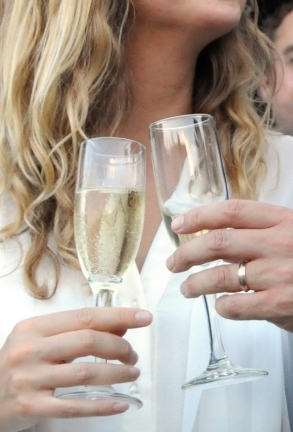Happy 10th anniversary to SO Vermont Arts & Living. That the issue is centered on anniversaries makes writing about sparkling wine a natural choice. Sparkling wine has been associated with celebrations since 496, when a Champenois warlord named Clovis defeated the Romans, carving out a mini-state around Reims, one of Champagne’s principal cities.The wine served for that occasion was local. From that year forward, French kings and queens were coronated in Reims’ famous cathedral, toasting their future with wine from Champagne.
Champagne is “a word that creates an air of effervescent expectation,” says Richard Juhlin in Champagne Guide. As Champagne has set the standard for sparkling wines, we’ll start there, then touch on more cost-effective alternatives to Champagne for larger celebrations such as weddings.
What makes Champagne unique? As quipped Pascal Leclerc-Briant, president of Champagne Leclerc-Briant until his death in 2010, “First, we have very bad weather. Second, we have our three grape varieties and chalky soil and all that. Thirdly, we have 330 pages of regulation.”
Indeed, the institute that regulates a sense of place in products throughout France, from wines to cheese and even lavender, has specified the place, grapes, and process of Champagne.
Although many people use the term to apply to any wine that has bubbles, more accurately it refers to sparkling wine from the northeast of France, approximately 100 miles (160 km) east of Paris. That region is famously defined by chalky soils that presumably impart a chalky minerality to the wines.
Champagne is made from only a few grape varieties, principally Chardonnay, Pinot noir and Pinot Meunier, (though four other varieties are allowed, they constitute only 0.3 percent of the plantings in Champagne) which are first made as individual still wines. That is, the juice of the grapes brought in from the vineyards is fermented separately by variety, by vineyard, and by lots within vineyards to produce a number of individual still wines.
Here’s to us!
So you’ve got your occasion, your place, your grapes, and your regulations. What’s next? Plenty!
• Blending: After the juice is made into individual wines, still wines are blended across grape varieties, across different vineyards, even across vintages (hence non-vintage) with the intention to produce a whole greater than the sum of its parts—more complex, and more connected from initial entry to finish, to produce a balanced whole.
Predicting how the wines will interact overtime makes blending an art. It generally takes years of experience to have a good sense of how a blend might taste over time.
• Bubbling: Once blended, the wines are bottled, then topped off with a mixture of sugar and wine that starts a second fermentation—this time inside the bottle—trapping the gas produced during fermentation in the bottle, which explodes into bubbles when uncapped.
Brilliant idea!
• Aging: Within the 330 pages of regulations to which Leclerc-Briant referred is the requirement that the wines must age for at least 15 months after they are blended. During that time, the yeast cells that provoked fermentation break down and impart flavors (bread, toast, brioche, caramel) and texture (creaminess) to the wine.
Tiny bubbles, a sign of quality, is a product both of the length of time aging on the spent yeast cells, called lees, and the temperature of the cellar in which the wine was aged.
Champagne provides a full sensory experience. It is a beautiful, interesting wine in the glass, with its filigree bubbles forming delicate threads to the wine’s surface, with an elegant energy on the palate.
It offers aromas and flavors—from citrus, pear, and cherry to brioche, pumpernickel, and brown butter, to smoke, sandalwood or toffee—and don’t forget that beguiling minerality.
Champagne is indeed magical, in a glass by itself. No wonder Winston Churchill used it to rally support for Britain’s WWI war effort after four already long years. “Remember gentlemen, it’s not just France we are fighting for, it’s Champagne!”






















































